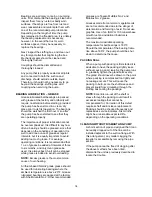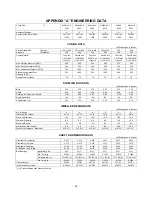
19
MAINTENANCE TIME TABLE
EVERY MONTH
Check bearing temperature with a thermometer, not by hand. If bearings are
running hot (over 180°F), it may be the result of too much lubricant. If changing the
lubricant does not correct the condition, disassembly and inspect the bearings. Lip
seals bearing on the shaft may also cause the housing to run hot. Lubricate lip
seals to correct.
EVERY 3
MONTHS
Check grease lubricated bearings for saponification. This condition is usually
caused by the infiltration of water or other fluid past the bearing shaft seals and
can be noticed immediately upon inspection, since it gives the grease a whitish
color. Wash out the bearings with a clean industrial solvent and replace the grease
with the proper type as recommended.
EVERY 6
MONTHS
Check the packing and replace if necessary. Use the grade recommended. Be
sure the seal cages are centered in the stuffing box at the entrance of the stuffing
box piping connection.
Take vibration readings on the bearing housings. Compare the readings with the
last set of readings to check for possible pump component failure (e.g. bearings)
Check shaft or shaft sleeve for scoring. Scoring accelerates packing wear.
Check alignment of pump and motor. Shim up units if necessary. If misalignment
reoccurs frequently, inspect the entire piping system. Unbolt piping at suction and
discharge flanges to see if it springs away, thereby indicating strain on the casing.
Inspect all piping supports for soundness and effective support of load. Correct as
necessary.
EVERY YEAR
Remove the upper half of the casing. Inspect the pump thoroughly for wear, and
order replacement parts if necessary.
Check wear ring clearances. Replace when clearances become three (3) times
their normal clearance or when a significant decrease in discharge pressure for the
same flow rate is observed. See Engineering Data Section for standard
clearances.
Remove any deposit or scaling. Clean out stuffing box piping.
Measure total dynamic suction and discharge head as a test of pump performance
and pipe condition. Record the figures and compare them with the figures of the
last test. This is important, especially where the fluid being pumped tends to form a
deposit on internal surfaces. Inspect foot valves and check valves, especially the
check valve which safeguards against water hammer when the pump stops. A
faulty foot or check valve will reflect also in poor performance of the pump while in
operation.
NOTE:
The above time table is based on the assumption that after start-up, the unit had been constantly
monitored and such a schedule was found to be consistent with operation, as shown by stable readings.
Extreme or unusual applications or conditions should be taken into consideration when establishing the
maintenance intervals.
















































